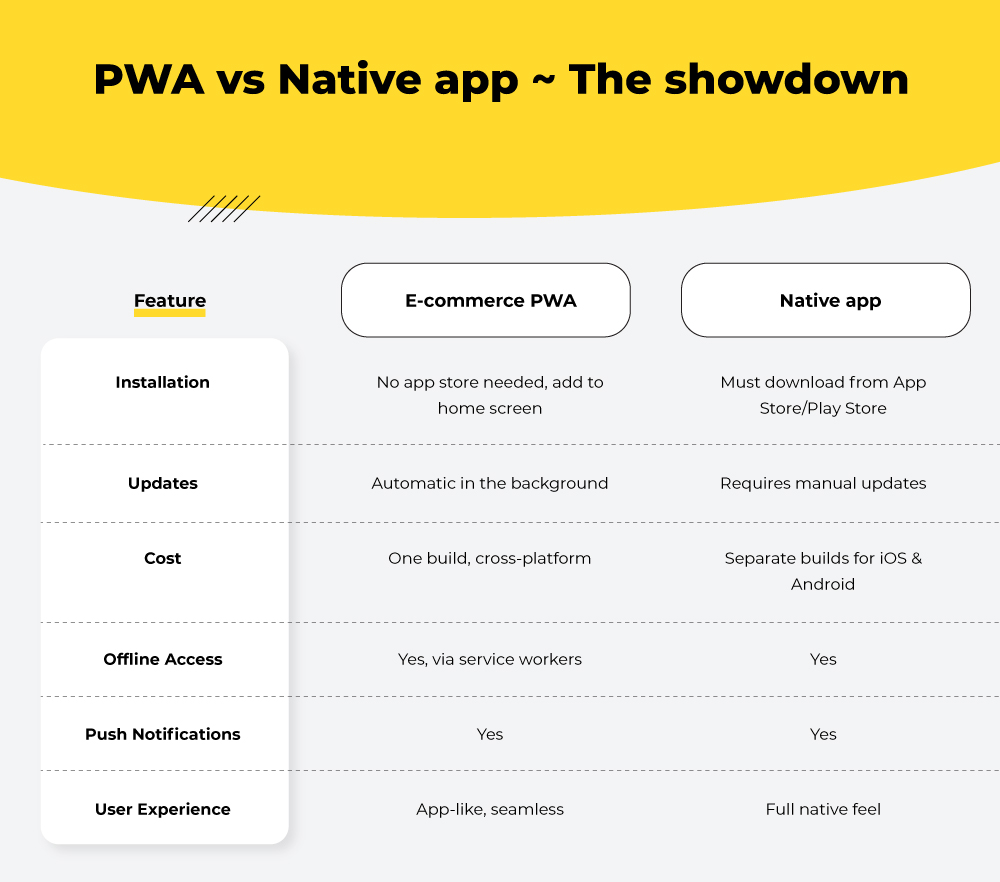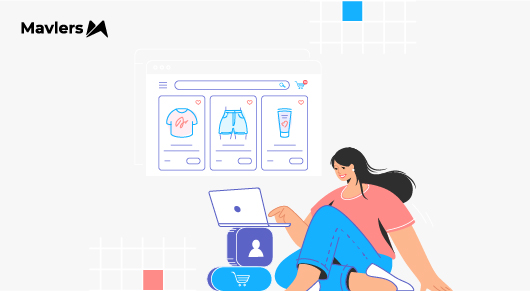So, you have just clocked out of a busy day and hit the comfiest recliner in your den. As you unwind and scroll through Instagram, an ad for sneakers catches your eye. You click through.
The site loads… slowly. The spinning wheel keeps turning. You sigh, lock your phone, and move on. That brand just paid for your click, got you interested, but lost the sale before it even started.
Now flip the script. Same ad. Same couch. You click. This time, the site opens instantly. Browsing feels buttery smooth, almost like you’re inside a mobile app, but you never had to download anything.
Even when your Wi-Fi hiccups, the store still shows you products without a glitch. You add to the cart. You check out. Done.
That’s the quiet revolution of the Progressive Web App for e-commerce, the cog quietly turning leaky funnels into high-converting shopping experiences.
And if you’ve been wondering why brands like Alibaba, Flipkart, and Lancôme made the switch, and whether it’s worth pitching to your own team or clients, let’s dig in.
With our 13+ years of experience and expertise in the web dev sphere, we’ll walk you through how a PWA for ecommerce works, why it outperforms old-school setups, and what it means for marketers like us who live and breathe traffic, conversions, and ROI.
An honest insight into why e-commerce needs something way better than just a website!
Honestly, e-commerce has a love-hate relationship with mobile. On the one hand, mobile devices now drive more than half of global online shopping. On the other hand, most mobile sites still feel like a clunky version of their desktop counterparts. Pages crawl. Buttons misfire. Connections drop.
And here’s the painful part: consumers don’t wait around. According to Google, more than half of mobile visits are abandoned if a page takes longer than 3 seconds to load. Three seconds! That’s shorter than the time it takes to sip your coffee.
Native apps tried to solve this problem. They offer speed and personalization, but they come with their own headaches: high development costs, the need to maintain separate iOS and Android builds, and the simple fact that most users don’t want to download an app for every store. Unless you’re Amazon, your app may end up buried in someone’s phone, opened once, then forgotten.
That leaves e-commerce brands in a bind: the web is too slow, native apps are too costly. So what’s the middle ground?
Enter the e-commerce PWA, which promises the best of both worlds.
So, what exactly is an e-commerce PWA?
You may think of a Progressive Web App as a website that’s been to finishing school. It still runs in a browser, but it feels and functions like a mobile app. Users don’t need to install anything from the App Store or Google Play; they can simply pin your site to their home screen, and voilà, it behaves like an app.
But here’s the kicker: it doesn’t just look app-like. Under the hood, it utilizes modern web technologies to deliver features once exclusive to native apps, including offline browsing, instant loading, push notifications, and seamless navigation.
In other words, a progressive web app store gives your users the speed and experience they crave, while giving you the reach and accessibility of the web.
How PWA works in e-commerce
So, a PWA for ecommerce runs on three key building blocks:
- Service workers are like invisible assistants. They sit between your browser and the network, storing data in the background. That’s how a shopper can still browse cached product pages when their train goes underground.
- App shell architecture ensures that the skeleton of your store, including navigation, header, and footer, loads instantly, while only the content inside changes. That’s why flipping through product categories feels lightning-fast.
- Web app manifest is what lets users save your store to their home screen, complete with your logo and colors, just like a native app.
Combine those pieces, and you get an e-commerce experience that’s reliable, fast, and engaging, without the friction of downloads or endless reloads.
Encapsulating a shopper’s journey in an e-commerce PWA
Let’s map out how it actually feels in real life.
So, Sarah lands on your store through a Google Ads campaign (we paid search folks made that happen).
Instead of waiting 8 seconds for the homepage to load (where she’d bounce), your PWA loads in under 3 seconds.
She taps through categories. The app shell keeps navigation lightning fast.
Internet cuts out while she’s in the subway? No worries. Service workers show cached pages.
She adds products to her cart. At checkout, she gets a smooth, app-like form with autofill.
A week later, your push notification reminds her of an abandoned cart, displayed straight on her phone’s lock screen, eliminating the need for email spam.
That sequence, from smooth browsing to offline resilience to push notifications, is why ecommerce PWAs don’t just capture clicks, they capture conversions.
PWA vs Native app for e-commerce: The reality check
Let’s see how PWA and native apps measure up to each other in an honest and unbiased way.

While native apps still have the upper hand in a few areas, deep integrations like AR shopping or advanced device features. But for the majority of e-commerce stores, a PWA vs native app for e-commerce comparison leans heavily in favor of PWAs:
- They install faster (no app store needed).
- They update silently in the background (no “update available” prompts).
- They cost less to build and maintain.
- They reach more people because they’re just a link away.
Unless your brand is investing heavily in features that demand native power, the e-commerce PWA is usually the smarter bet.
How Progressive Web App speeds up e-commerce websites
To wrap your head around why Progressive Web App speeds up e-commerce websites, think of it like pre-packing your orders before the customer arrives.
- Instead of fetching everything from the server on each click, PWAs cache resources locally.
- Service workers ensure repeat visits feel instantaneous.
- The app shell ensures that only the content refreshes, not the entire layout.
That’s why e-commerce PWAs load up to 2–4x faster than traditional mobile sites.
But should every e-commerce store go the PWA way?
Now, should every e-commerce site run to build a PWA? Here’s our take:
If you’re a small boutique with a limited tech budget and 80% of your sales are desktop-based, it may not be urgent.
But if you’re running paid campaigns, driving mobile traffic, watching bounce rates climb, or struggling to justify the cost of a native app? Yes, an e-commerce PWA is worth every penny.
Are you still on the fence about making the right choice? Then our detailed guide on “Progressive Web Apps vs. Native Apps: The Ultimate Guide to Choosing the Right Fit” might help!
The road ahead
Wondering if PWAs are the way to go in the near future? We recommend reading: Are Progressive Web Apps the Evolutionary Next Step Towards Responsive Ones?


Naina Sandhir - Content Writer
Latest posts by Naina Sandhir - Content Writer (see all)
Google Ads for ABM campaigns: How to align paid search with sales goals
Fix email fatigue with retention-first, AI-driven strategies (for SaaS & e-commerce)